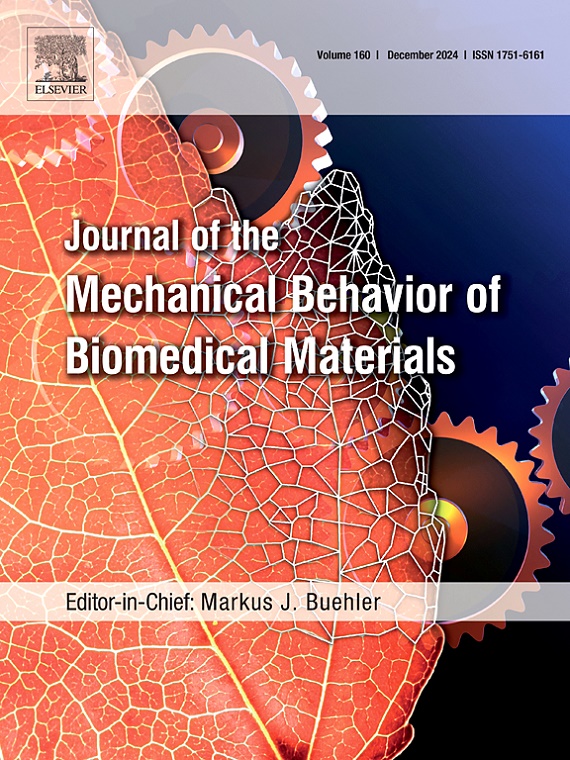Measuring full-field strain of the muscle-tendon junction using confocal microscopy combined with digital volume correlation
IF 3.3
2区 医学
Q2 ENGINEERING, BIOMEDICAL
Journal of the Mechanical Behavior of Biomedical Materials
Pub Date : 2025-02-01
DOI:10.1016/j.jmbbm.2025.106925
引用次数: 0
Abstract
The muscle-tendon junction (MTJ) is a specialized interface that facilitates the transmission of force from the muscle to the tendon which has been implicated in muscle strains and tears. Understanding the transmission of forces and the strain generated in the MTJ is therefore important. For the first time, we report the 3D full-field strain distribution across the muscle-tendon junction (MTJ) using in-situ tensile testing and confocal microscopy coupled with digital volume correlation (DVC). This approach allowed us to measure the mechanical behaviour of the MTJ at the fibre/fascicle level. Acridine orange (AO) in 70% ethanol was used to enhance the contrast of the mouse Achilles-gastrocnemius MTJ, and the specimens were rehydrated prior to the tensile testing, which was performed using custom made tensile rig that fitted under the confocal microscopy. The 3D full-field strain distribution was obtained using DVC, where the strain changes were measured from confocal images taken with the MTJ under preload (0.4 N) and loaded (0.8 N and 1.2 N) representing 2.7- and 4-times body weight. High strain concentration was observed at the junction for both 0.8 N and 1.2 N loads. At the junction, the first principal stain (εp1), shear strain (γ) and von Mises strain (εVM) reached 15.2, 34.2 and 19.2% respectively. This study allowed us to measure fascicle level strain distribution at the MTJ. Using histology, microtears at the MTJ were seen in specimens loaded with 1.2 N which were associated with von Mises strain concentration in the adjacent region. The microtears occurred in regions where the strain level was between 8 and 15%. This study developed a methodology to determine high-resolution strain distribution at the MTJ and has the potential to be used to analyse the strain at the cellular level using higher magnification objectives.
求助全文
约1分钟内获得全文
求助全文
来源期刊

Journal of the Mechanical Behavior of Biomedical Materials
工程技术-材料科学:生物材料
CiteScore
7.20
自引率
7.70%
发文量
505
审稿时长
46 days
期刊介绍:
The Journal of the Mechanical Behavior of Biomedical Materials is concerned with the mechanical deformation, damage and failure under applied forces, of biological material (at the tissue, cellular and molecular levels) and of biomaterials, i.e. those materials which are designed to mimic or replace biological materials.
The primary focus of the journal is the synthesis of materials science, biology, and medical and dental science. Reports of fundamental scientific investigations are welcome, as are articles concerned with the practical application of materials in medical devices. Both experimental and theoretical work is of interest; theoretical papers will normally include comparison of predictions with experimental data, though we recognize that this may not always be appropriate. The journal also publishes technical notes concerned with emerging experimental or theoretical techniques, letters to the editor and, by invitation, review articles and papers describing existing techniques for the benefit of an interdisciplinary readership.
 求助内容:
求助内容: 应助结果提醒方式:
应助结果提醒方式:


